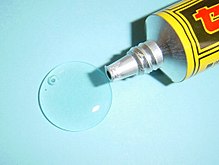An adhesive is a non-metallic substance that bonds materials together by resisting separation. From simple craft projects to complex aerospace applications, these remarkable binding agents have shaped human innovation for over 200,000 years.
Historical Origins
The story of adhesives begins with Neanderthals, who created tar from birch bark to attach stone tools to wooden handles[1]. By 70,000 years ago, humans in Sibudu, South Africa developed compound adhesives using plant gum and red ochre, creating stronger tools that revolutionized early technology[1].
Types and Classifications
Non-Reactive Adhesives
These adhesives work through physical changes. Drying adhesives like white glue harden when their solvent evaporates[1]. Pressure-sensitive adhesives, found in sticky notes and tape, form bonds with light pressure and can be permanent or temporary[1].
Reactive Adhesives
These create chemical bonds during curing. Multi-component adhesives combine materials like polyester and polyurethane resins to form strong connections[1]. UV-curing adhesives harden in seconds under ultraviolet light, making them vital in electronics and medical device manufacturing[1].
Modern Applications
Industrial Uses
The automotive industry relies on specialized adhesives for bonding metal, rubber, and plastics. Pre-mixed and frozen adhesives (PMFs) serve aerospace applications, requiring storage below -40°C to maintain their properties[1].
Consumer Products
From woodworking to packaging, adhesives play countless roles in daily life. Natural adhesives like starch-based pastes still dominate certain markets due to their low cost and environmental friendliness[1].
Adhesion Mechanisms
Successful bonding requires three key properties: wetting ability, strength development, and load distribution[1]. Adhesives can work through mechanical interlocking, chemical bonding, or electromagnetic forces like van der Waals interactions[1].
Safety and Performance
Environmental factors like sunlight, heat, and solvents can weaken adhesive bonds[1]. Modern adhesive design focuses on creating optimal geometry for maximum bonding area and stress distribution, particularly in load-bearing applications[1].
Future Developments
The field continues to evolve with new synthetic formulations and improved natural alternatives. Research focuses on developing stronger, more environmentally friendly adhesives that can withstand extreme conditions while maintaining reliable performance[1].
Citations:
https://en.wikipedia.org/wiki/Glue
Adhesive, also known as glue, cement, mucilage, or paste, is any non-metallic substance applied to one or both surfaces of two separate items that binds them together and resists their separation.

The use of adhesives offers certain advantages over other binding techniques such as sewing, mechanical fastenings, and welding. These include the ability to bind different materials together, the more efficient distribution of stress across a joint, the cost-effectiveness of an easily mechanized process, and greater flexibility in design. Disadvantages of adhesive use include decreased stability at high temperatures, relative weakness in bonding large objects with a small bonding surface area, and greater difficulty in separating objects during testing. Adhesives are typically organized by the method of adhesion followed by reactive or non-reactive, a term which refers to whether the adhesive chemically reacts in order to harden. Alternatively, they can be organized either by their starting physical phase or whether their raw stock is of natural or synthetic origin.
Adhesives may be found naturally or produced synthetically. The earliest human use of adhesive-like substances was approximately 200,000 years ago, when Neanderthals produced tar from the dry distillation of birch bark for use in binding stone tools to wooden handles. The first references to adhesives in literature appeared approximately 2000 BC. The Greeks and Romans made great contributions to the development of adhesives. In Europe, glue was not widely used until the period AD 1500–1700. From then until the 1900s increases in adhesive use and discovery were relatively gradual. Only since the 20th century has the development of synthetic adhesives accelerated rapidly, and innovation in the field continues to the present.

